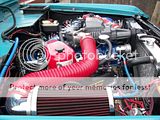SN 93 is real nice. I respect your aim is not to create a gasoline alley bred road burner, so what you have will do in a mild sense. Show some discipline and a mild kit will reward.
Basic engine is limited by its piston quality, its plastercine rod bolts, insufficient oil pump capacity, a sump needs windage tray and bigger capacity wings, the lifters on all sixes can remove more oil than exists in the sump. A better qulity timing gear set is needed. Then there's the standard
Lincs 200 problem of just one point of fuel distribution feeding six cylinders, and it doesn't matter if its a Clifford 2-bbl adaptor, its fuel distribution is not good under boost when it goes through one 1-bbl hole.
That 38 DGES, if it has 27 mm venturis, tries to flow 1.77 sq in of 2-bbl down one 1.3" hole of 1.32 sq in for the early 61-69 I6's, then to the 1.5" (1.77 sq in) from 1970 to 1977, then only up to a 1.75" hole on the 1978-1983 heads, or 2.40 sq inches. So some combinations of direct adaptors are no where near as good as a direct mount 2-bbl. Even Tripower set ups are very poor for port area, with as little as1.09/1.5/1.09 carb holes on early Offenhausers to up to 1.4375,1.75,1.4375 on the later ones. Still not much space for any more than three 29 mm venturis on the 1904 Holley and Weber 34 ICH or ICT 1-bbl carbs (3.07 sq in). We see about 181 and 220 flywheel hp with these on 200 and 250 cube engines, respectively. See
kevinl1058 viewtopic.php?t=64712#p496848 and
FordSedanDelivery's very quick cars on
viewtopic.php?f=1&t=66999#p528778. Stock 38DGEV's are great inclusions, but its hard to get over 130 hp with a bolt on adaptor. Considering some get 205 flywheel hp with there 200's an just a direct mount log and 264 cam, you might like to consider the cost of just an alloy head and cam with a good carb instead.
With your mild 5 psi boost ratio, a stock adaptor 38DGEV won't make more than 180 hp supercharged unless you do some head and carb work. If that's along the highway to where your headed, then you'll be happy with that, but there's much more with just carfull attention to detail
A good Holley 2-bbl 350 sits at 2.21 sq inches, a 500cfm 2.97 sq in, and so a supercharged engine with just 1.77 sq in is really going to cause the airflow to get very restricted fast.
On my Supercharged engines, I use a very simple version of the better three hole tri power manifolds which duplicates the porting of the later D8 to E0 cylinder heads. The stock intake ports are small, but since you can can bolt three honed out mechanical secondary 32/36DGV carbs on, and rout out three holes manifold to a huge 1.83" and take the
three carbs out to 350 cfm
each; you can get more progressive and wide open throttle carb venturi area than a 427 Tripower six pack (6.18 sq in), but run it as as a independent runner set of six barrels. That is able to reach an easy 425 hp with just one 112 cubic inch M112 supercharger and 14 pounds of boost.
So long story short, I'd try for a direct mount Weber carb on a later head (see user
Crosley's posts, and then open out the venturis to 31 mm from the stock 27mm.(see
MercuryMarc's posts)
Mustangaroo":1xpbi5u9 said:

The above picture is the Paxton SN/89 mounted on the passagers side of my 1968 Mustang, I've had this setup for about five years, I had to relocate the battery to the trunk for the above installation. I am currently working on a drivers side install using the power steering mount. Sorry the engine bay is so dirty but this has been a daily driver for almost five years, I recently got a new H3 Hummer to replace the Mustang as my daily driver, hence I now can try something new.
8)

And the Broncitus album
http://s717.photobucket.com/albums/ww17 ... 3QQtppZZ16




